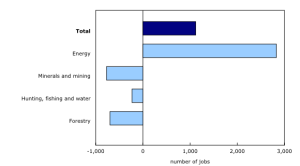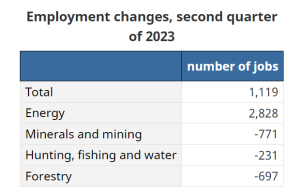
OTTAWA – Real gross domestic product (GDP) of the natural resources sector decreased 0.4 per cent in the second quarter, the third consecutive quarterly decline. In contrast, the economy-wide real GDP was nearly unchanged.
The decrease in real GDP in the second quarter was driven by the forestry (-4.4 per cent), minerals and mining (-2.2 per cent) and hunting, fishing and water (-1.8 per cent) subsectors. At the same time, the energy subsector increased 0.4 per cent.
The decline in the forestry subsector was attributable to primary sawmill and wood products (-6.5 per cent), which reflected drops in new construction (-8.2 per cent) and renovation activities (-4.3 per cent) and coincided with higher borrowing costs and lower demand for mortgage funds.
 In the minerals and mining subsector, declines in real GDP of metallic (-3.7 per cent) and non-metallic (-5.2 per cent) minerals were partly offset by a rise in real GDP of coal (+5.6 per cent). Metallic and non-metallic minerals’ real GDP decreased, as a combination of maintenance and forest fires caused operations to close. The increase GDP of coal was partly due to higher rail carloadings and exports to South Korea.
In the minerals and mining subsector, declines in real GDP of metallic (-3.7 per cent) and non-metallic (-5.2 per cent) minerals were partly offset by a rise in real GDP of coal (+5.6 per cent). Metallic and non-metallic minerals’ real GDP decreased, as a combination of maintenance and forest fires caused operations to close. The increase GDP of coal was partly due to higher rail carloadings and exports to South Korea.
The increase in real GDP of the energy subsector was attributable to an increase in services (+4.3 per cent), but it was weakened by decreases in natural gas (-2.6 per cent), refined petroleum products (-0.4 per cent) and crude oil (-0.3 per cent). Forest fires in Alberta caused many operations to slow or stop production, which impacted natural gas extraction and crude oil production.
Quarterly Export And Import Volumes Rise
Natural resources exports rose 0.5 per cent, with increases in the minerals and mining (+3.2 per cent) and energy (+0.1 per cent) subsectors being offset by a decline in the forestry subsector (-4.7 per cent). In the minerals and mining subsector, exports of unwrought gold posted large increases for both volumes and prices on high transfers of gold assets from Canadian financial institutions to the United States. Lower demand for primary sawmill and wood products contributed to the decrease in the forestry subsector.
Import volumes of the natural resources sector were up (+1.2 per cent) in the second quarter. Import volumes of the minerals and mining subsector rose 12.0 per cent largely due to primary metallic minerals products (+26.3 per cent), notably unwrought gold, silver and platinum group metals from the United Kingdom. Import volumes of the energy subsector decreased 6.7 per cent. Lower import volumes of refined petroleum products (-11.9 per cent) were due to reduced gasoline inventories in the United States.
Crude oil import volumes (-2.1 per cent) were down, partly due to lower shipments from Saudi Arabia and the United States. These decreases were partially offset by an increase of natural gas import volumes (+5.2 per cent). In the second quarter, import volumes decreased for the forestry subsector (-5.6 per cent) due to primary pulp and paper product imports falling (-5.8 per cent). Import volumes for the hunting, fishing and water subsector fell (-3.4 per cent).
Natural Resources’ Prices Fall
Overall, natural resources’ prices decreased 2.1 per cent in the second quarter, while the GDP implicit price rose 0.7 per cent in the second quarter, as consumer inflation remained elevated. Prices fell in the forestry (-5.6 per cent), energy (-2.0 per cent) and minerals and mining (-1.2 per cent) subsectors in the second quarter. Primary pulp and paper products (-11.1 per cent) led the decrease in the forestry subsector due to a slowdown in global demand (especially from China) and excess supply, which put downward pressure on prices. The fall in the minerals and mining subsector was mainly attributable to coal (-25.5 per cent), and the decline in the energy subsector was heavily influenced by natural gas (-13.1 per cent) and crude oil (-4.5 per cent).
Natural resources’ nominal GDP fell 2.6 per cent in the second quarter to $315.6 billion at annual rates, representing 11.9 per cent of the Canadian economy.
 Employment Increases
Employment Increases
Employment in the natural resources sector rose 0.2 per cent in the second quarter. The energy subsector (+2,800 jobs) recorded increases in employment, and the minerals and mining (-800), forestry (-700 jobs) and hunting, fishing and water (-200 jobs) subsectors recorded decreases.
Business Examiner Submitted


